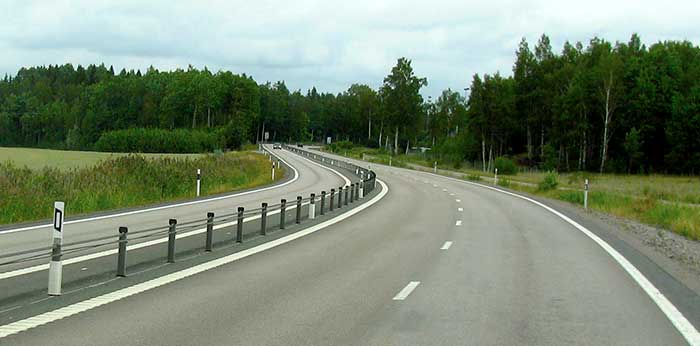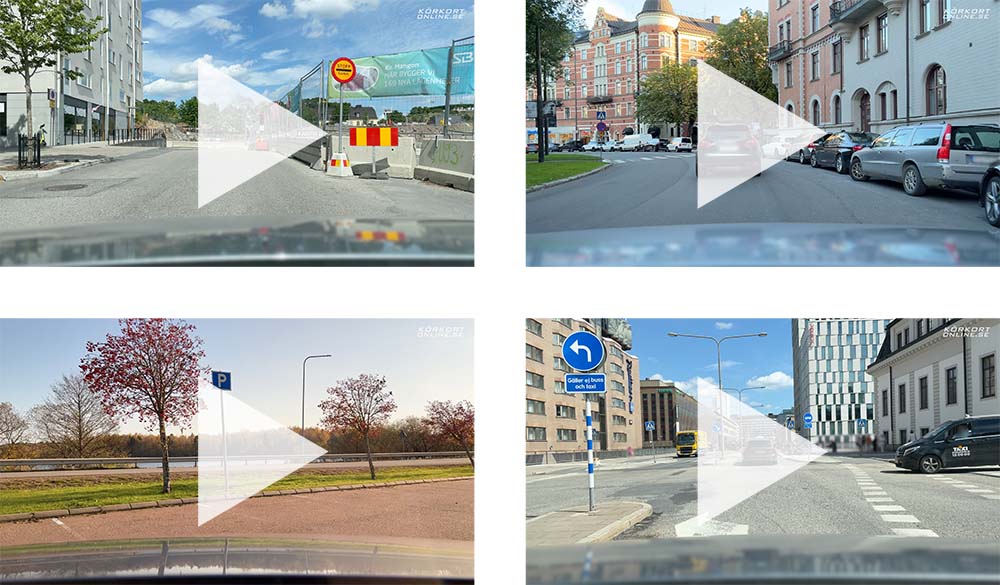Motorways & clearways
Motorways
- Indicated by the Motorway sign.
- Traffic travelling in different directions is always separated. In other words, there are no oncoming cars.
- No intersecting traffic on the same level.
- Both exit and entry slip roads are part of the motorway, which means that the same rules apply to them.

A typical motorway. Traffic is separated, and intersecting traffic crosses the road via a bridge.
Motorway entry slip roads
- If there is an acceleration lane, neither those in the acceleration lane nor those already on the motorway have priority. Mutual consideration and adaptation apply.
- If there is no acceleration lane, those entering have an obligation to give way to traffic already on the motorway.
- Leave the entry slip road as soon as you can. Remember to check your blind spot.
On a motorway, it is forbidden to:
- Stop or park.
- Turn around (central barrier openings are only intended for rescue vehicles and road workers).
- Reverse.
- Walk, cycle or drive a moped.
- Tow.
- Drive a vehicle that is not designed to travel at least 40 km/h.
- Exception: Class I mopeds (45 km/h) are forbidden.
- Drive a tractor.
Risks associated with motorways
Motorways are generally safe to drive on. However, there are a few risks that you should pay particular attention to:
- Distorted perception of speed after exit (speed blindness).
- Multiple-vehicle collisions due to insufficient distance between vehicles.
- Monotonous driving can lead to single-vehicle accidents.
- In wet conditions, the risk of aquaplaning increases with speed.
Notice the white car. Nobody has priority. Mutual consideration and adaptation apply.
You are not allowed to stop at the red arrow, even though it looks like an appropriate place to stop.
Clearways
A clearway is a mix of motorway and country road. Things to keep in mind:
- No intersecting traffic, but oncoming traffic may occur (rare, cable barriers are often used).
- The same rules and prohibitions as on motorways apply.
- Accidents occur more frequently than on motorways (shorter entry slip roads, less space to the sides).
Clearways are always indicated by the Clearway sign. There are also country roads with cable barriers that are not clearways. On such roads, intersecting traffic may occur.
Speed blindness

A 2+1 road with cable barriers.
When you slow down after a prolonged period of driving at high speeds, it often feels that the speed you are driving at is lower than it actually is. This phenomenon is known as speed blindness, and can result in you misjudging distances and your stopping distance.
The risk of speed blindness increases with:
- Wide roads without any distractions.
- Quiet and comfortable cars.
- Driving at high speeds for a prolonged period.
Heavy lorries
- Heavy lorries may drive at a maximum 90 km/h on motorways and clearways. On other types of road, the maximum speed for heavy lorries is 80 km/h.
Latest forum posts
- << Country road
- Motorway & clearway ↑↑
- Overtaking >>






